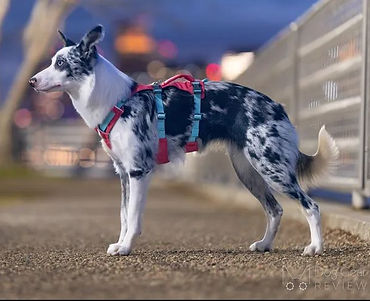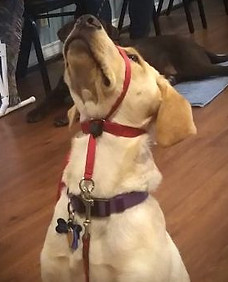
Making tails wag since 1996!
3400 N. Monroe St. - Spokane, WA
Questions? EMAIL!

EQUIPMENT CHOICES.
The good, the bad, and the ugly.
Positive reinforcement training does not rely on corrections to teach.
-
We will not use equipment that is designed to deliver corrections or cause discomfort. We do not use choke, prong or shock collars to subdue or control our dogs. You will not learn how to "pop" your leash or force your dog into position.
-
Collars, harnesses, leashes, and long-lines are for keeping your dog safe - they are life insurance, not corrective devices for punishment.
-
Your dog should wear a well-fitted flat collar with license and ID tags so if your dog gets lost, whoever finds them, can find you. Remove neck collars for safety when your dog is wrestling with friends.
-
The most gentle equipment is uncomfortable if you haul your dog around and keep the leash tight. Any equipment could injure your dog if you suddenly yank on it, or he is running fast when he hits the end of the leash.
Suggested equipment:
The following are fine for non-pullers - trained dogs:
Flat web or leather collars - To hold his license and name tag. Use after your dog has learned to walk on a slack lead. Make sure they are fitted snugly enough that they won't slip off over the dog's head. The wider the collar, the less discomfort on the dog's throat if they lean into it. If your dog is leaning hard against his collar, choose a front-hooking harness or head collar instead to avoid pressure and possible injury to their trachea.
Limited-slip or martingale-type collars - they tighten so they won't slip off for safety, but when fitted properly, they cannot choke. Particularly good choices for dogs with wide necks or narrow heads who have already learned to walk nicely on a slack leash.
Learning to walk nicely on a slack leash takes time and practice. Until then:
Front-hooking harnesses - There are many brands and styles that make walking your dog on leash easier for you and more comfortable for your dog. It also eliminates pressure on the throat and neck area. The best harnesses have a ring to hook your leash at the front of the chest. This makes it possible to direct the dog. Even better, harnesses like the Freedom and Balance Harnesses have hooks at the back and the front so you can provide two points of contact to communicate with a double-ended lead and switch to just the back hook when your dog has learned to walk without pulling.

A slack leash hangs like a smile!
Does your dog pull on leash? Find some tips here.

Baby puppy?
We recommend a comfortable, easy to put on, and inexpensive Y-front or vest type harness to start with, since young puppies will quickly grow out of whatever fits at first! It's better to have one that fits, rather than buying something with room to grow - they could easily slip out of that too-large harness. Once they are nearing full size, you can invest in a high-quality harness that will fit their adult body. (See a few great options and links to more in the Fitting section below.)
VIDEOS
Teaching a dog to enjoy being handled, not just tolerate it
Get Dressed!
Teach your pup to love getting dressed for a walk.
Putting your dog's harness on doesn't have to be a struggle. Wrestling it on when you are in a hurry is a sure way to teach your pup to hate their harness. Being grabbed and restrained, shoving it over their sensitive ears and having their legs bent in uncomfortable angles, and the loud snap of buckles will quickly teach your dog to run away and hide when it's time for a walk. This can also result in a dog becoming difficult to groom and hard to catch. Your pup who used to come happily may soon avoid coming when called.
Cooperative Care! A little bit today, a little bit tomorrow. Introduce the harness gently and slowly with lots of rewards for tiny steps: see it, sniff it, peek through it, reach through to take a treat, etc. Let your pup take a break if they need to. If you need help, we do have trainers who offer private lessons to help you.
Pulling? Snap your leash to the front of your harness.
This will give you directional control when you need it and keeps the pressure off the trachea. Hooking the leash to the back of a harness on a powerhouse puller increases forward momentum and could lead to aggression out of frustration. Hooking your leash to the front of your harness allows you to direct your dog gently and reduces frustration for both you and your dog.
Whole Dog Journal article: "The Best Front Clip Dog Harnesses"
Selection and Fitting
HARNESS FITTING
The harness should fit above the shoulder blades so the dog has full extension and range of motion of their shoulders. There should be plenty of room behind the elbow to prevent chafing or pinching.

HOW TO CHOOSE A WELL-FITTING Y-HARNESS FOR YOUR DOG
This great article from the Dog Gear Review page shows a variety of harness styles and explains the importance of how and why the harnesses fit well, or don't, for particular dogs.


Our current favorites:
Lupine Roman Harness (Y front)
Perfect Fit Harness
Petforma Harness
Visit Prairie Dog Pet Mercantile and they will help fit your dog!
Our least favorite:
Easy Walk Harness

Ruffwear Flagline Harness - two belly straps.
Great for escape artists who back out of their harness or collar, with a handle for helping them in and out of the car or up and down steps.

Check the fit!
Too low, too tight = uncomfortable!

Harnesses to Avoid
Choose a harness that fits high above the shoulder blades to allow full extension of the shoulders and make sure it doesn't bind in the armpits. Avoid harnesses with restrictive chest straps.
Impedes normal gait
In these examples, the weight of the extra hardware, fabric and leash on the Easy Walk harness pulls the front of the harness down, restricts the forward reach of the front legs.


Pinching at the elbows!
These harnesses are too tight and the chest strap is too low in the front, causing restriction of the shoulder and binding and chafing in the armpit. OUCH!
HEAD COLLARS

Head collars - For large dogs with small humans, strong pullers, or dogs who lunge.
Gentle Leaders or Halti head collars make it possible for you to redirect your dog like turning a horse with a halter. These collars make it easier for small humans with power house pullers or when working with reactive dogs, as you can turn the head and guide the dog in a smooth arc away from what they are alarmed or excited about. No choking or trachea damage, as the pressure is on the bridge of the nose, not the throat.

If your dog lunges and barks when he sees other dogs:
A Gentle Leader or Halti head collar will make it easy for you to gently turn his head away from what he is straining toward and reduce his frustration. Over the years we have noticed an increase in leash frustration. We see a direct correlation between dogs who regularly engage in high arousal, rough-and-tumble play with unfamiliar dogs at the dog park and dogs who lose their minds barking when they see another dog. If your dog is over-excited, you may find taking a break from the dog park and daycare while you establish new habits will make a huge difference.
LEASHES & LONG LINES

Your leash should be soft and easy-to-hold, made of leather or fabric, (NO CHAIN OR FLEXI-LEASHES) 4 ft to 6 ft in length. The width should feel comfortable in your hand and have an appropriately-sized snap for the size of your dog. Too thin and it will cut into your hand if your dog suddenly lunges. Too thick or too wide and it will be bulky and hard to grip.
A double-ended leash (with a snap at each end) can be attached to both front and back of a no-pull harness, or to a head collar and a neck or body harness for safety and added control.
FOR SAFETY: Please do not bring your dog into the classroom on a retractable (flexi) leash.
Why not?

No retractable/flexi- leashes in class, please!

Long lines are simply long leashes. Leashes are generally 4-6' long. Long lines could be 10, 15, 20, 30 feet long. Used for distance training. The long line is life insurance when working on distance stays and recalls or when giving your dog a little more freedom on the trail. A light house-line can be used for safety inside. In the case of a door dasher, you can quickly step on the line to prevent escape if the door suddenly opens. If your dog does escape, you can step on the line and calmly collect him, rather than the impossible task of trying to get hold of his collar.
Hands-free - waist leashes!
The Trail Runner System: Whole Dog Journal's Review - Whole Dog Journal

A hands-free waist leash can free up your hands while training. For distance work, a long-line (15-30 ft) gives you safety in open areas.

NOT ALLOWED IN CLASS
-
No Choke chains
-
No Prong or pinch collars
-
No Electronic collars


WHY PRONG COLLARS HURT - by Eileen Anderson
The fall-out of corrections and discomfort.
The seeming behavior "fix" is all too often accompanied by negative fall-out. Please read this position statement by the Pet Professional Guild. The article is regarding shock in animal training, but the same fall-out occurs with all aversive corrections. It's a major problem when a dog makes the unintended association that the appearance of a person or another dog predicts pain or startle from a collar correction to his neck. The result can be increase in fear/avoidance to escape, or an increase in aggression in an attempt to drive the perceived cause of the discomfort away. It may temporarily suppress one behavior, while creating other - and far worse - behavior issues.
Teach your dog what you DO want, rather then setting out on your training venture armed to punish what you don't.
It's not necessary, easier, or faster to use force and punishment. And you'll increase your bond and relationship through positive training methods.


This handout may be reprinted in its entirety for distribution free of charge and with full credit given:
© CAROL A. BYRNES "DIAMONDS IN THE RUFF" Training for Dogs & Their People -
ditr_training @ hotmail.com - http://www.diamondsintheruff.com
The San Francisco SPCA has taken the bold step of making a position statement on the use of prong collars. They have also created some great educational information and resources.
www.sfspca.org/prong


